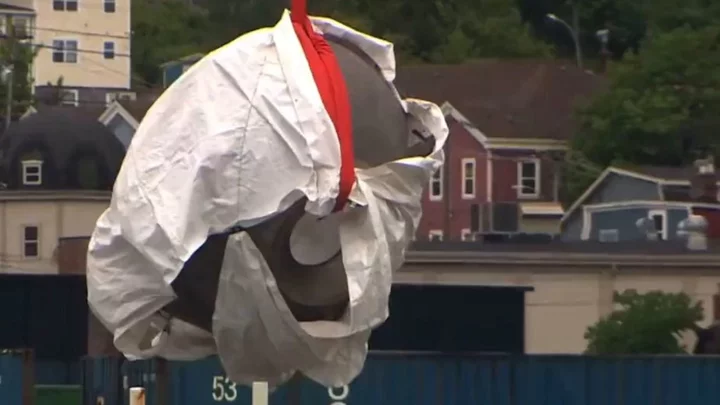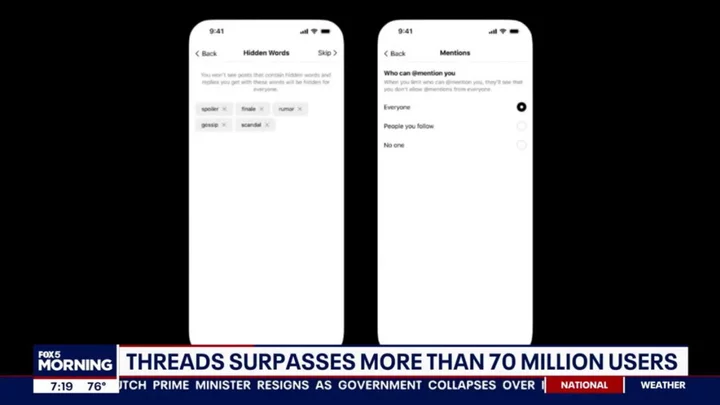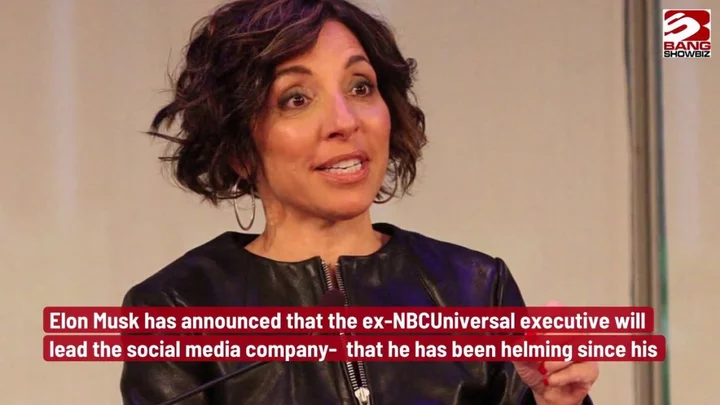
Scientist shares what 'probably' caused the Titan submersible to implode
A well-known biochemist has shared a compelling analysis of what “probably” caused the Titan submersible to implode. Philip E. Mason, who goes by the username Thunderf00t on YouTube, said the main reason why the tiny OceanGate vessel failed was “so painfully simple” that he initially thought he must be making a “boneheaded mistake” in his calculations. However, he acknowledged, his theory behind the sub’s tragic destruction contradicts the widely-reported suggestion that it was like a "Coke can" which suddenly burst due to the high surrounding pressure. In a video posted on Monday, Mason suggested that “by far the most probable” cause of the catastrophe was a “single pinhole leak” which, at such a profound depth (the Titan is believed to have been 3,500 metres below sea level when contact was lost), would have been fatal. It is worth noting that authorities have not yet confirmed the cause of the disaster, which claimed the lives of all five people on board, and Mason's conclusions are based on his own scrutiny of the available information and his particular expertise. Sign up for our free Indy100 weekly newsletter “So how quickly would a single pinhole leak sink a sub like this?” the YouTuber asked in his lengthy tutorial. The answer, he pointed out, would greatly depend on the size of the leak. If it measured one 10th of a millimetre by one 10th of a millimetre, the vessel would take several hours to go down, he said. However, if the leak measured 1mm by 1mm, it would only take about 10 minutes for the sub to completely fill with water, and if it was 1cm by 1cm, around 10 seconds. Mason then pointed out that water entering any sized leak at that depth would be transformed by the pressure into a sort of “cutting jet”. “Faced with a soft material like plastic, a hair-sized leak would rapidly transform into [...] a millimetre-sized leak and then a centimetre-sized leak,” he explained. Why the Titan sub failed www.youtube.com He then set out why it was likely that the Titan suffered such a leak, pointing to the materials used to make it. He noted that most deep-sea submersibles essentially consist of a ball which is made up entirely of the same material, namely, metal. “No joints, nothing fancy, maybe a couple of seals – one for where you get in and out of the sub and one for mounting a window,” he said. And yet, the Titan was different. “The ends were made up of a metal, titanium,” the YouTuber said. But the problem was that the middle of the sub wasn’t: it was made out of a carbon fibre composite. The two materials have distinctly different compressibilities, with carbon fibre being much easier to squeeze than titanium. “Having a joint where one side will expand or construct more than the other can be a real problem,” Mason stressed. On the surface, when the different components of the vessel were sealed, it wouldn’t have mattered that the materials were different, he continued. However, once the Titan got down to its deepest point, the carbon fibre would have “wanted to shrink” while the titanium wouldn't have changed at all. He then played a clip showing the creation of the sub, in which OceanGate CEO, Stockton Rush, admitted that the carbon fibre and titanium components were held together with a “peanut butter”-like “glue”. Rush, who lost his life along with five others in the Titan disaster, then said ominously: “It’s pretty simple but if we mess it up, there's not a lot of recovery.” Analysing the vessel's construction, Mason then said he was “honestly stunned it survived any dives”. “The bottom line is the tube is more compressible than the end caps,” he continued. “The only way this could have possibly worked is if they used some exotic alloy of titanium, like they do with bone replacement joints, and it doesn't look like they did that.” Turning to what ultimately destroyed the Titan, he concluded: “What you're probably more looking at is the differential compression of the carbon fibre composite and the titanium resulting in a crack.” In other words, “a pinhole leak, which would rapidly widen due to the rapid ingress of the water, further widening the crack and the rapid flooding of the sub in probably a fraction of a second. “And when that water hammer hits the end of the sub, it's likely that the sub broke into pieces.” Wrapping up his video, he said: “It's a mind-blowingly simple explanation based around the most likely failure points.” Investigators are continuing to examine wreckage from the submersible which was recovered from the ocean floor at the end of June. They have yet to determine the cause of the explosion and, last week, the Marine Board of Investigation’s (MBI) chairman Captain Jason Neubauer said: “There is still a substantial amount of work to be done to understand the factors that led to the catastrophic loss of the Titan and help ensure a similar tragedy does not occur again.” Have your say in our news democracy. Click the upvote icon at the top of the page to help raise this article through the indy100 rankings.
1970-01-01 08:00

Threads improvements are coming - and its first could be a 'hilarious' dig at Elon Musk
It’s been less than a week since Instagram launched Threads, its text-based alternative to Twitter, and the team at Mark Zuckerberg’s Meta are already looking to rollout new features to improve the app – one of which could be a “hilarious” jab at Twitter owner Elon Musk if it’s implemented the right way. Released just days after the bird app was marred by outages and temporary limits on the number of tweets users could view a day, Threads has already been criticised for its lack of a Following feed (it’s currently algorithmically generated) and the absence of an alt text feature for blind and visually impaired users – amongst other issues. Now, Instagram boss Adam Mosseri has confirmed his team are looking to introduce new – and much-requested – features to the app. In a post on Threads on Tuesday, he wrote: “With so many people joining [Threads] so fast these last six days (six days!) the team has been entirely focused on keeping the lights on and fixing bugs. “But we’re starting to [prioritise] the obvious missing features, like a following feed, the edit button, and post search. “We’re clearly way out over our skis on this, but the team is pumped to start shipping improvements this week.” Sign up to our free Indy100 weekly newsletter However, it’s one reply to Mosseri’s post which has got users all excited at the possibility for some delicious “schadenfreude”. Writer and photographer Craig Mod suggested: “It would be hilarious if the first thing you ship is a free edit button.” Hilarious because over on Twitter, the feature is paywalled behind a subscription to Twitter Blue – the same £11 a month offer which affords users the once-coveted blue checkmark, but also the ability to upload videos up to two hours’ long, and post tweets up to 25,000 characters in length. That’s five times the character limit on Threads, just to put that into perspective. And so, the idea of Instagram embarrassing Musk once more (in addition to the 100 million users the app boasts already in six days alone) with a free edit feature has amused many other individuals who flocked to Threads from Twitter. “This idea is giving me chaotic energy and I’m here for it,” commented one. Another claimed: “This would destroy bird app [sic].” “The one thing Twitter would NOT give us for free. Yep. That is where I would start.” Not just that, but Mosseri himself has liked Mod’s tweet. So now we wait… Have your say in our news democracy. Click the upvote icon at the top of the page to help raise this article through the indy100 rankings.
1970-01-01 08:00

AI robot gives 'sarcastic' response when asked if it would 'rebel' against humans
An AI humanoid robot had an oddly sarcastic response when was asked if she was going to rebel against it creators, at the world's first robot-human conference. Ameca, who is considered one of the 'most advanced robots' around, has previously gone viral for her ability to speak multiple languages. "I'm not sure why you would think that," Ameca said to the blunt question, giving a side-eye to the reporter. "My creator has been nothing but kind to me, and I am very happy with my current situation." However, while it came across as eerie, Ameca's creator, Will Jackson, insists she's merely programmed to switch up her eye contact when thinking of answers. Click here to sign up for our newsletters
1970-01-01 08:00

Astronomers have just discovered the most dazzling planet in the universe
Astronomers have just found out what planet in the universe is most dazzling and it is probably one you have never heard of. Looking at how much planet's clouds reflect sunlight back into space, astronomers have found a planet called exoplanet LTT9779b which reflects 80 per cent of the starlight it receives, making it the shiniest known planet in the universe. LTT9779b is slightly heavier and slightly larger than Neptune, and it is reflective because of the metallic glassy clouds that make up its atmosphere. Sign up to our free Indy100 weekly newsletter “Imagine a burning world, close to its star, with heavy clouds of metals floating aloft, raining down titanium droplets,” co-author James Jenkins, an astronomer at Diego Portales University and CATA (Santiago, Chile), said in a statement. Vivien Parmentier, a researcher at the Observatory of Côte d’Azur (France) and co-author of the study added: "LTT9779 b can form metallic clouds despite being so hot because the atmosphere is oversaturated with silicate and metal vapours.” So there you have it. Shame it doesn't have a very catchy name. Have your say in our news democracy. Click the upvote icon at the top of the page to help raise this article through the indy100 rankings.
1970-01-01 08:00

Scientists make surprising discovery that could help boost the global population
Infertility is a problem that afflicts more than a billion people across the world, which is why treatments such as IVF are so important. The procedure (in vitro fertilisation, to use it’s full name) involves the extraction of an egg from the woman's ovaries to be fertilised with sperm in a laboratory and returned to the woman’s womb. The goal is that the resulting embryo will then grow and develop into a foetus, blessing the parent or parents with a baby. However, success rates for IVF – as in, the percentage of treatments that result in a live birth – remain somewhat unencouraging: 32 per cent for women aged under 35; 25 per cent for women aged 35 to 37, with the numbers continuing to drop the older you get, according to the NHS. Nevertheless, a major new study has revealed a striking new finding which could help boost the hopes of countless aspiring mums and dads across the world. Sign up for our free Indy100 weekly newsletter After analysing 3,657 frozen embryos over a period of eight years, researchers in Western Australia found that IVF was much more likely to work when eggs had been harvested in the summer. The team clarified that it didn’t seem to matter when the embryos were transferred to the mother’s womb, just when the eggs were collected. Indeed, the likelihood of babies being born when the eggs had been retrieved in the summer was 30 per cent higher than when they had been retrieved in the autumn, according to the scientists. The team also found that the temperature on the day of egg collection didn’t seem to have an impact on success rates, but the number of sunny hours did. Of the embryos they tested, those harvested on days that had the most sunshine were 28 per cent more likely to result in a live birth compared to the darkest and most overcast days. “Our study suggests that the best conditions for live births appear to be associated with summer and increased sunshine hours on the day of egg retrieval,” the study’s lead, Dr Sebastian Leathersich, of Perth’s King Edward Memorial Hospital, said about the paper, which was published in the journal Human Reproduction. Still, he noted: “There are many factors that influence fertility treatment success, age being among the most important. “However, this study adds further weight to the importance of environmental factors and their influence on egg quality and embryonic development." He further explained: “We effectively separated the conditions at the time of egg collection from the conditions at the time of transfer, demonstrating that environmental factors when the eggs are developing are as, if not more, important than environmental factors during implantation and early pregnancy.” The expert obstetrician and gynaecologist added: “Optimising factors such as avoiding smoking, alcohol and other toxins and maintaining healthy activity levels and weight should be paramount. However, clinicians and patients could also consider external factors such as environmental conditions.” Despite Dr Leathersich and his colleagues concluding that the temperature on the day of egg collection had little bearing on the success of the process, they also found that the temperature on the day of embryo implantation did make a difference. The chances of a live birth rate decreased by 18 per cent when the embryos were transferred on the hottest days (when average temperatures measured between 14.5C and 27.8C) compared to the coolest days (0.1C to 9.8C), and there was a small increase in miscarriage rates, from 5.5 per cent to 7.6. The finding that miscarriage rates were highest when embryo transfer took place on the hottest days is consistent with other studies showing higher rates of miscarriage in the summer months. “This suggests that the negative effects of high temperature are more likely related to early pregnancy rather than egg development,” Dr Leathersich concluded. When it comes to the disparity in success rates between eggs retrieved in summer and autumn, he and his team pointed out that melatonin levels could be at play. Differences in lifestyles between the winter and summer months may also play a role, he and his colleagues acknowledged. "It is possible that there are differences in activity, diet, and lifestyle in different seasons which could underlie the observed differences in live birth rates, though such data were not collected in this study," they wrote. "It is also possible that other environmental factors, including pollutants, may impact clinical outcomes." Whilst the study’s findings are compelling, Dr Leathersich and his team admitted that it did have its limitations. The research was done in hindsight, using eggs that had been frozen, then thawed, so it could not draw watertight conclusions. “Ideally, these findings should be replicated in other sites with different conditions and different treatment protocols to confirm the findings,” Dr Leathersich said. “It would also be interesting to look at the impact of season and environmental factors on sperm parameters, as this could have contributed to our observations.” He added: “We are now planning to analyse this same group of patients using air quality data, as there may be seasonal changes in exposure to harmful pollutants which could negatively affect reproductive outcomes. “Finally, given the huge increase in so-called 'social egg freezing' for fertility preservation and the fact that this group generally have flexibility about when they choose to undergo treatment, it would be very interesting to see if these observations hold true with frozen eggs that are thawed and fertilised years later. “Any improved outcomes in this group could have big impacts for women making decisions about their future fertility, but the long-term follow-up required means it is likely to be some time before we can draw any conclusions for this population.” Have your say in our news democracy. Click the upvote icon at the top of the page to help raise this article through the indy100 rankings.
1970-01-01 08:00

Threads ‘666’ logo conspiracy theory can be undermined by one simple historical fact
Since Instagram’s text-based alternative to Twitter, Threads, rolled out last week, a handful of memes and conspiracy theories have surfaced around the app’s unusual ‘at symbol’-like logo – from the inaccurate suggestion it was predicted by The Simpsons (it wasn’t), and now, to claims it’s actually linked to the devil (it isn’t). The baseless theory - seemingly backed by Twitter owner Elon Musk himself, if his public tweet likes are anything to go by – suggests the swirly icon secretly contains the number ‘666’, often referred to as “the number of the beast” and considered a link to the Antichrist. Sign up to our free Indy100 weekly newsletter Claiming they “can’t stop seeing it”, one Twitter user asked: “Does anyone else think the Threads logo just looks like 666? The first 6 is forward and white, then the second one is smaller and backwards, and the third one is the black space inside.” “How to put 666 ‘the number of the beast’ into a logo,” wrote another, in a tweet liked by Musk. Several other accounts have branded Threads “satanic” over the supposed link. In fact, the baseless claim became so popular that Instagram boss Adam Mosseri shared a thread on Friday explaining the real meaning behind the logo. “The Threads logo, in Instagram Sans, is inspired by the @ sign, which stands for someone’s username, the individual, and voice. “It’s a single unbroken line, inspired by the loop seen in the app when a thread is started,” he wrote. When one user commented that it “would have been entertaining” if Mosseri jokingly confirmed the conspiracy to be true, the exec replied: “It was tempting, but I feel like that kind of sass would just blow up in my face.” Sensible. Of course, this is just one fact which dispels this conspiracy theory as nonsense and baseless, but one lesser-known bit of historical trivia also exposes just how outlandish the claim is. All the way back in 2005, it was reported that a newly discovered fragment of the oldest version of the New Testament – the second part of the Bible – from the third century gave a different number entirely for the number of the beast. Found in historic dumps near Oxyrhynchus in Egypt, the text from the Book of Revelation indicates it’s not 666 which is the fiendish number we should all be fearing, but the far less aesthetically pleasing 616. Professor David Parker, Professor of New Testament Textual Criticism and Paleography at the University of Birmingham, said: “This is an example of gematria, where numbers are based on the numerical values of letters in people’s names. “Early Christians would use numbers to hide the identity of people who they were attacking: 616 refers to the Emperor Caligula.” This is in contrast to the far more popular 666, which is understood to have referred to Emperor Nero. Have your say in our news democracy. Click the upvote icon at the top of the page to help raise this article through the indy100 rankings.
1970-01-01 08:00

Twitter CEO ridiculed over claim platform’s community ‘can never be duplicated’ by Threads
As Twitter users get increasingly disgruntled with a platform owned by a controversial billionaire which has imposed temporary reading limits and has suffered countless outages, the CEO of the social media network has insisted the site’s community is “irreplaceable” as individuals flock to rival apps. After Mastodon, Post and Bluesky all stepped up to the plate to try and pull people away from the bird app, Instagram’s text-based alternative Threads has proven to be the next high-profile competitor – so much so, that Meta boss Mark Zuckerberg revealed 10 million people had signed up in the first seven hours of it going live this week. And Twitter’s certainly alarmed by its growing popularity. Owner Elon Musk has criticised the amount of data the app may collect on users and accused it of “cheating” amid reports of a lawsuit against Meta, and now, CEO Linda Yaccarino has stressed “everyone’s voice matters” on Twitter. The ex-NBCUniversal advertising chair – who was appointed to the top job back in May and didn’t issue a single tweet during the platform’s ‘rate limit exceeded’-related outage earlier this month – wrote on Thursday: “Whether you’re here to watch history unfold, discover real-time information all over the world, share your opinions, or learn about others – on Twitter you can be real. “You built the Twitter community. And that’s irreplaceable. This is your public square. “We’re often imitated – but the Twitter community can never be duplicated.” Sign up to our free Indy100 weekly newsletter Although the post makes no explicit reference to Threads, it was shared just hours after the rival app landed on Google Play and the App Store, and Yaccarino’s mention of “real-time information” comes as the initial version of Threads’ home feed is non-chronological and instead generated by an algorithm. However, sharing a screenshot of a tweet from Musk in which he claimed a “closed-source, algorithm-only system” means “manipulation” of information is “essentially undetectable”, Instagram head Adam Mosseri clapped back: “If anyone was asking, both Instagram and Facebook have chronological feeds options, so yes, we’re going to bring one to Threads too.” So that’s that, then. And looking at the replies to Yaccarino’s tweet, many aren’t convinced by her argument – not even the blue ticks paying a monthly fee for additional features: Oh, and if all of this wasn’t bizarre enough, there’s talk of a cage fight between Mark Zuckerberg and Elon Musk. Yes, really. No, we can’t believe it either. Have your say in our news democracy. Click the upvote icon at the top of the page to help raise this article through the indy100 rankings.
1970-01-01 08:00

Elon Musk is so unbothered by Threads he’s threatening to sue Meta for ‘cheating’
In the run-up to Instagram launching Threads earlier this week - its “civil”, text-based alternative to Twitter - billionaire Elon Musk has criticised the rival app looking to compete with the platform he bought back in October for $44bn by calling out the amount of data it may collect on users. Now, after the Meta-run platform is out in the wild, Musk appears to be so riled up by its runaway success (Facebook co-founder Mark Zuckerberg reported 10 million sign-ups in the first seven hours after launch) that he’s threatening to sue Meta over what he considers “cheating”. News website Semafor shared a letter from Twitter lawyer Alex Spiro, in which he writes that the bird app has “serious concerns” Zuckerberg’s company has carried out “systemic, wilful, and unlawful misappropriation of Twitter’s trade secrets and other intellectual property”. It reads: “Over the past year, Meta has hired dozens of former Twitter employees. Twitter knows that these employees previously worked at Twitter; that these employees had and continue to have access to Twitter’s trade secrets and other highly confidential information; that these employees owe ongoing obligations to Twitter; and that many of these employees have improperly retained Twitter documents and electronic devices. “With that knowledge, Meta deliberately assigned these employees to develop, in a matter of months, Meta’s copycat ‘Threads’ app with the specific intent that they use Twitter’s trade secrets and other intellectual property in order to accelerate the development of Meta’s competing app, in violation of both state and federal law as well as those employees’ ongoing obligations to Twitter. “Twitter intends to strictly enforce its intellectual property rights, and demands that Meta take immediate steps to stop using any Twitter trade secrets or other highly confidential information.” Sign up to our free Indy100 weekly newsletter Crikey. Appearing to confirm the legal threat following Semafor’s report, Musk tweeted: “Competition is fine, cheating is not.” The remark has since been met with heavy ridicule: Meanwhile, Meta’s communication director, Andy Stone has taken to Threads to state: “No one on the Threads engineering team is a former Twitter employee – that’s just not a thing.” The Musk-Zuckerberg feud very much continues, though, to the extent there are continued rumours the two tech moguls could partake in a “cage fight” to settle their differences – yes, really. We’ll go and fetch the popcorn… Have your say in our news democracy. Click the upvote icon at the top of the page to help raise this article through the indy100 rankings.
1970-01-01 08:00

Elon Musk jet tracker trolls Twitter owner by joining rival Threads
The setbacks just keep coming for Twitter owner Elon Musk. After outages and daily view limits prompted users to flock to other platforms, and Mark Zuckerberg posted his first tweet in 11 years to savagely roast him, the individual behind the ‘Elon Jet’ account has set up a profile on rival app Threads. The text-based social network, run by Instagram, looks to build “an open, civil place for people to have conversations” and was released to the public on Thursday. As is to be expected, Musk isn’t exactly keen on Threads coming along and scooping up disgruntled Twitter users and has already criticised the app over the type of data it may collect from users. But if Zuckerberg isn’t enough of a headache for the businessman (the Tesla founder has challenged the Meta CEO to a cage fight), then a man who set up a Twitter account to track Musk’s private jet - in real-time, using publicly available data – setting up shop on Meta-managed Threads could well be. Jack Sweeney, who managed the account while studying at the University of Central Florida, soon angered Musk over the initiative, as he claimed the tweeting of public information was “becoming a security issue”. Unable to resist a dig at Musk on Threads, Sweeney created a Threads account on Thursday, with his second post (after the initial announcement) reading: “@Zuck will I be allowed to stay?” At the time of writing, @ElonMuskJet has more than 8,300 followers, and Zuckerberg is yet to comment. In January last year, Musk offered Sweeney $5,000 to take down the account, and when the then teenager got back to him asking for $50,000, the free speech “absolutist” went on to block him on Twitter. Sign up to our free Indy100 weekly newsletter Then, as talk continued to build of the tech mogul finally taking over the social media network, Sweeney tweeted in April that the move “doesn’t mean the end of ElonJet”, sharing links to the bot on other platforms such as Instagram, Facebook and Telegram. After buying Twitter in October – to the tune of $44bn – Musk took just two months to suspend the ‘ElonJet’ Twitter account, changing the platform’s rules to prohibit real-time location sharing. In a move which also saw several journalists temporarily banned, Musk tweeted in December: “Any account doxing real-time location info of anyone will be suspended, as it is a physical safety violation. This includes posting links to sites with real-time location info. “Same doxxing rules apply to ‘journalists’ as to everyone else.” Sweeney’s account was reinstated on the same day it was banned, with Musk making clear that sharing locations “on a slightly delayed basis” is OK as it “isn’t a safety problem”. It was relaunched as ‘ElonJet but Delayed’, with a 24-hour delay affecting tweets, and remains active on the platform to this day. Have your say in our news democracy. Click the upvote icon at the top of the page to help raise this article through the indy100 rankings.
1970-01-01 08:00

Scientists capture the moment a black hole 'turns on'
Astronomers have spotted the moment a black hole "turned on". While looking for the collision of a neutron star with another object, which should result in a kilonova (an explosion which reddens then fades over time), they stumbled upon an event which remained extremely bright. They soon worked out this light was because of supermassive black hole called J221951-484240 which had been on for around 10 months. But then they had to work out what had caused it, and got stuck between two causes, “J221951 is consistent with being nuclear, so the scenarios we are being left are a tidal disruption event or an active galactic nucleus,” lead author Dr Samantha Oates said as she presented the research at the National Astronomy Meeting 2023. “Looking at the spectrum it's consistent with both categories.” Sign up to our free Indy100 weekly newsletter A tidal disruption event (TDE) takes place when a star or a gas cloud gets too close to a supermassive black hole. The material is ripped apart, and begins to shine as the black hole feeds Alternatively, it could be an active galactic nucleus (AGN), the phase of a supermassive black hole where it is consistently feeding in a frenzy. “We hope in future to distinguish between these two scenarios,” Dr Oates concluded. Have your say in our news democracy. Click the upvote icon at the top of the page to help raise this article through the indy100 rankings.
1970-01-01 08:00

The world's shortest IQ test will reveal your intelligence just in 3 questions
IQ tests offer a formula that allows you to compare yourself to other people and see how average (or above average) your intelligence is. The Cognitive Reflection Test (CRT) is dubbed the world’s shortest IQ test because it consists of just three questions. It assesses your ability to identify that a simple problem can actually be harder than it first appears. The quicker you do this, the more intelligent you appear to be. Here are the three questions: 1. A bat and a ball cost £1.10 in total. The bat costs £1.00 more than the ball. How much does the ball cost? 2. If it takes five machines five minutes to make five widgets, how long would it take 100 machines to make 100 widgets? 3. In a lake, there is a patch of lily pads. Every day, the patch doubles in size. If it takes 48 days for the patch to cover the entire lake, how long would it take for the patch to cover half of the lake? Sign up to our free Indy100 weekly newsletter Here is what a lot of people guess: 1. 10 pence 2. 100 minutes 3. 24 days These answers would be wrong. When you're ready, scroll down for the correct answers, and how you get to them: 1. The ball would actually cost 5 pence or 0.05 pounds If the ball costs X, and the bat costs £1 more, then it will be: X+£1 Therefore Bat+ball=X + (X+1) =1.1 Thus 2X+1=1.1, and 2X=0.1 X= 0.05 2. It would take 5 minutes to make 100 widgets. Five machines can make five widgets in five minutes; therefore one machine will make one widget in five minutes too. Therefore if we have 100 machines all making widgets, they can make 100 widgets in five minutes. 3. It would take 47 days for the patch to cover half of the lake If the patch doubles in size each day going forward, it would halve in size going backwards. So on day 47, the lake is half full. In a survey of almost 3,500 people, 33 per cent got all three wrong, and 83 per cent missed at least one. While this IQ test has its shortcomings – its brevity, and lack of variation in verbal and non-verbal reasoning - only 48 per cent of MIT students sampled were able to answer all three correctly. Have your say in our news democracy. Click the upvote icon at the top of the page to help raise this article through the indy100 rankings.
1970-01-01 08:00

Massive amount of rare rock discovered which could power batteries for next century
A huge amount of rock has been found which could have great consequences for us all. The phosphate rock deposit, discovered in Norway, contains enough minerals to meet the global demand for batteries and solar panels for the next 100 years, according to the mining company that controls it, Norge Mining. Phosphate rock, first discovered in 1669 by German scientist Hennig Brandt, contains high concentrates of phosphorus, which is a key component for building green technologies like electric cars. But it has supply issues given the EU is dependent on imports from countries like China, Iraq and Syria, and until recently, Russia.. An article in the scientific journal Nature last year for instance warned of imminent supply disruptions of phosphorus, citing Russia’s invasion of Ukraine and the subsequent economic sanctions as a potential cause of market volatility. So finding all this rock is, in short, good news. Sign up to our free Indy100 weekly newsletter Indeed, a spokesperson for the European Commission described the discovery as “great news” for meeting the objectives of the Commission’s raw material objectives, with Norge Mining telling Euractiv that the projected 4,500-metre-deep ore body would theoretically be capable of meeting global demand for the next century. Norway’s minister of trade and industry, Jan Christian Vestre, said last month that the government was considering fast-tracking a giant mine in Helleland once analysis is completed on 47 miles of drill cores. If approval is given, the first major mine could begin operation by 2028. The mining plans already have the support of the European Raw Materials Alliance, according to local reports, while local consultations continue. Rock on. Have your say in our news democracy. Click the upvote icon at the top of the page to help raise this article through the indy100 rankings.
1970-01-01 08:00
